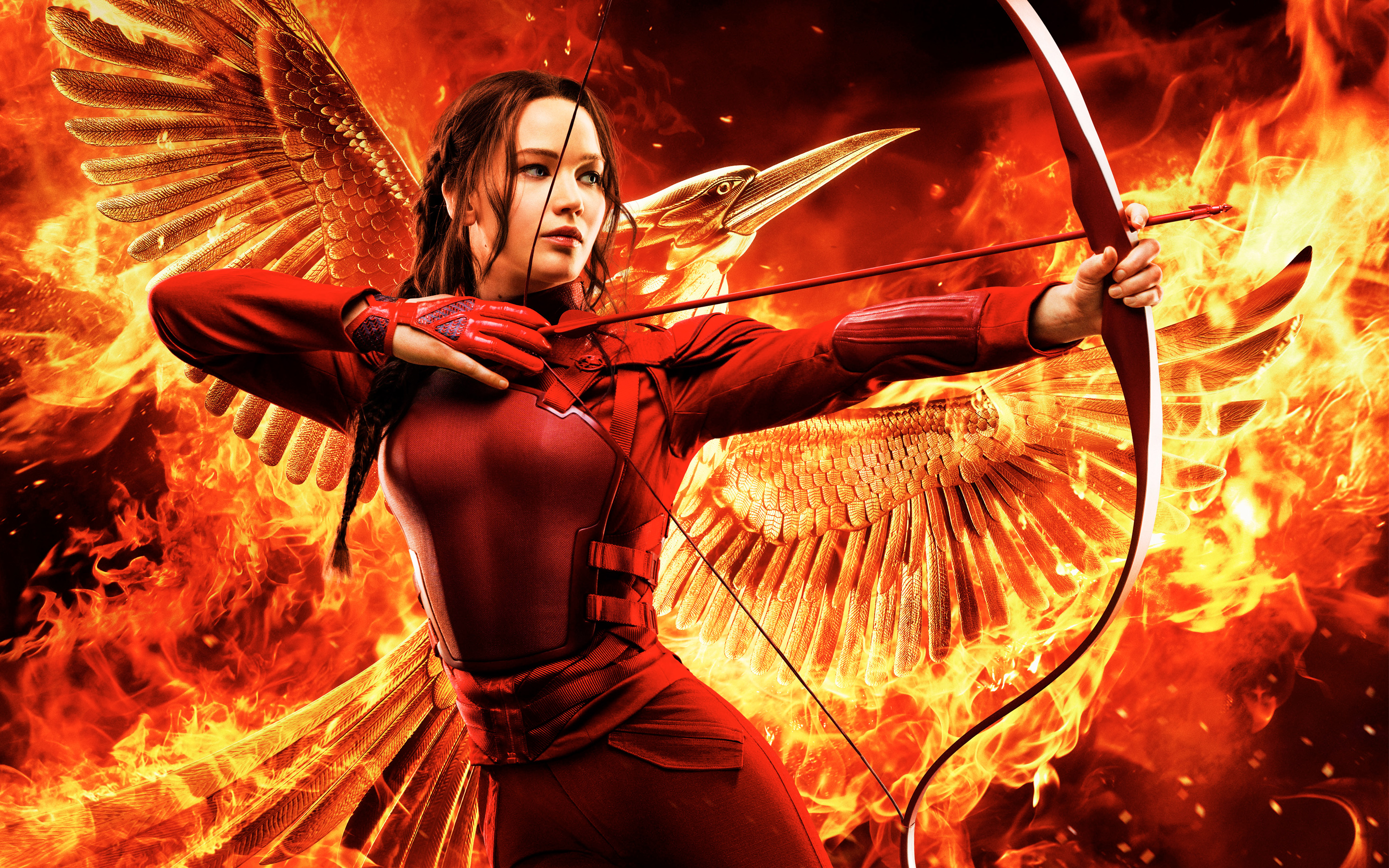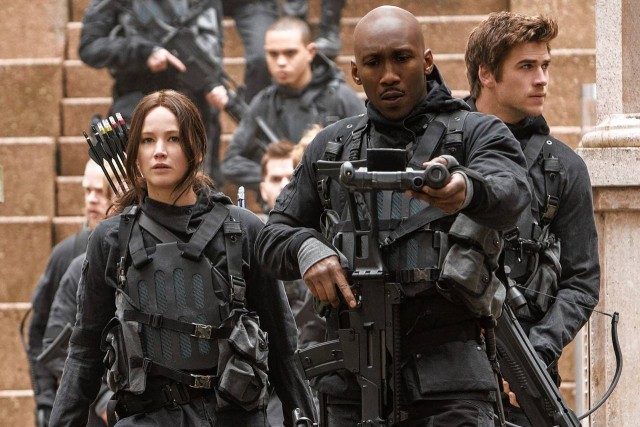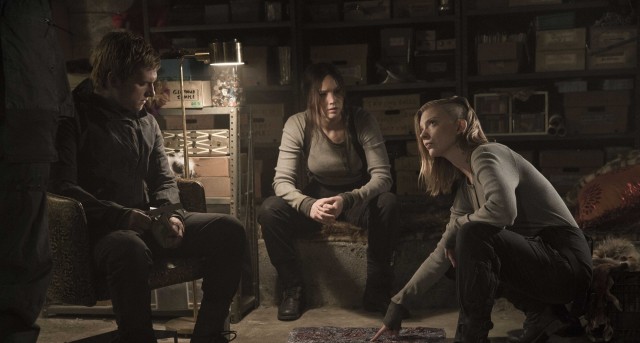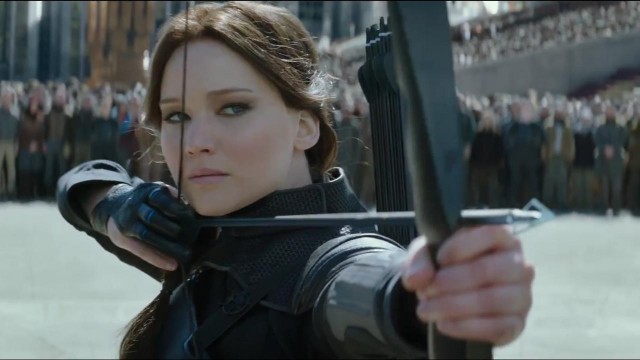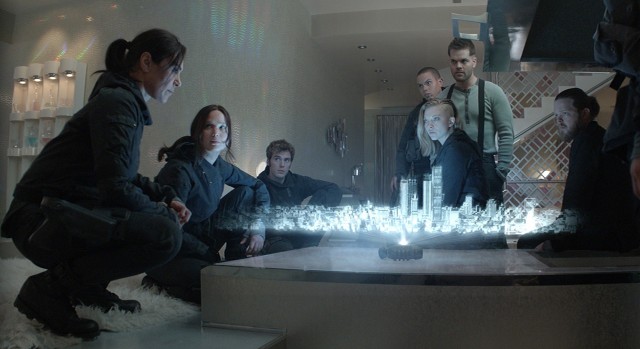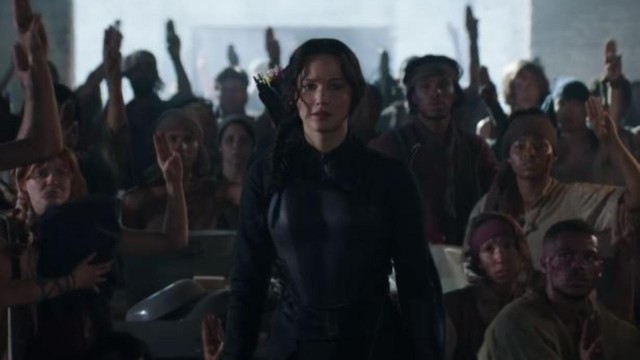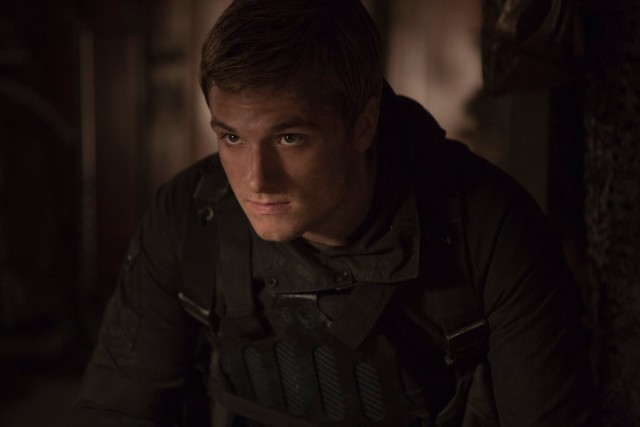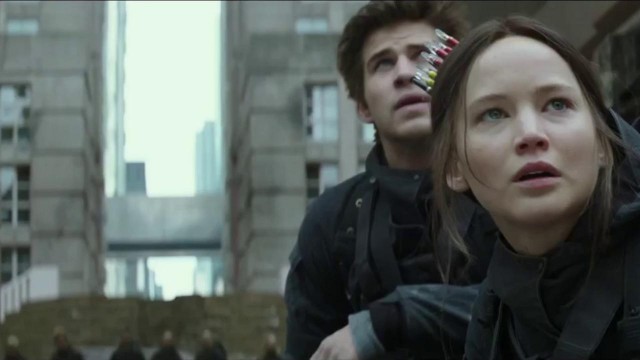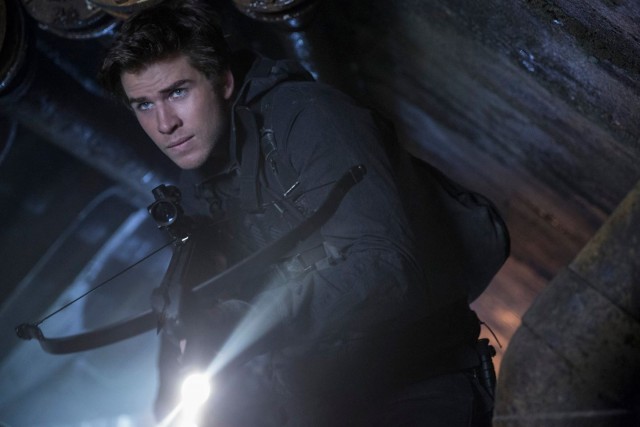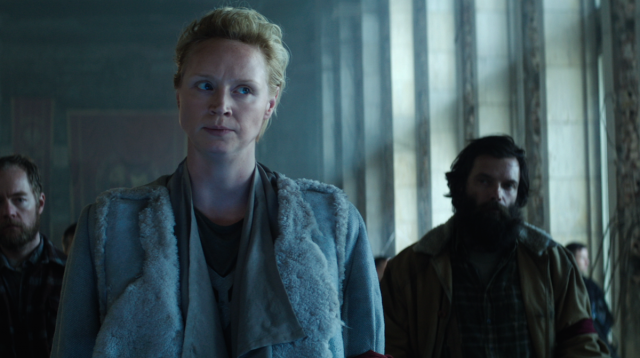The Hunger Games: Mockingjay – Part 1 sobered moviegoing audiences to a darker and less compromising war for Panem last year, even if it didn’t show what all of this unrest and rebellion would eventually lead to. That resolution instead comes in the form of The Hunger Games: Mockingjay – Part 2 this year, a powerful and shocking finale to the Hunger Games saga on the big screen… Albeit one that feels like it was created more out of necessity than genuine inspiration.
On its own merits, The Hunger Games: Mockingjay – Part 2 is a powerful movie about the cost of war, much like its predecessor from last year was. It’s objectively impressive and impactful, with a handful of truly spectacular sequences as the final push towards The Capitol is made… But, when stacked up against the prior three movies, it seems apparent that The Hunger Games: Mockingjay – Part 2 is sadly the weakest of the four, since it seems far too wrapped up with hammering home the overdone message that war is hell, to the point where it comes off as excessively heavy-handed, and frustratingly abandons a lot of the more intriguing, morally grey themes of its immediate predecessor.
The sporadic moments of outstanding spectacle at least continue to push the movies forward, and feel like the franchise still goes out on a decent, if not incredible note. There’s still enough drive and intensity in the battle against The Capitol to see everything through, particularly when the enemy becomes more and more desperate to stave off its inevitable demise. It also goes without saying that the cast is as sublime as ever, even with the unfortunate passing of Philip Seymour Hoffman last year, who had to be CG’d into certain scenes where Hoffman didn’t have speaking lines, with other characters delivering the dialogue that he was supposed to, as was the case with the previous movie.
Naturally, if you’re a fan of The Hunger Games, then this will obviously be required viewing, as this will be the resolution to the prior three movies that came beforehand. Much like the previous movie however, if you could care less about this franchise, then you don’t miss much by skipping The Hunger Games: Mockingjay – Part 2, which is predictably a direct extension of its predecessor, with more action substituted for the psychological warfare that’s now been largely omitted.
As I said, if there’s something elevating the Hunger Games movies above the experience of reading the books, it’s the cast. Every returning survivor is as great as ever in The Hunger Games: Mockingjay – Part 2, at least when the story gives them something to do beyond sit around and mope. Yes, there’s a surprising lot of that in this finale, even if the good scenes ultimately outweigh the dull ones.
The first movie left off with Peeta back in the care of District 13, and Peeta’s journey almost exceeds the depth over that of Katniss, who is more or less fully embracing the Mockingjay personality at this point, pushing on with a stubborn drive to see Snow brought to justice by any means. After being brainwashed by The Capitol, Peeta takes Katniss’ place as the war’s most reluctant participant, giving the rest of the Mockingjay squad full authorization to take him out if he looks to be doing anything suspicious. Peeta has always been one of the most likable characters in this franchise, even more so than Katniss, and seeing his torment be the most clearly defined is one of the best ways that the movie captures the stakes of its war, in lieu of actual large-scale combat.
Likewise, the final unfurling of President Snow’s control is pretty enjoyable to watch. Snow goes to yet more desperate lengths to keep his reign intact, ultimately turning his own city into a gauntlet of booby traps, and his own people into acceptable losses. The Cold War of The Hunger Games: Mockingjay – Part 1 has officially heated up, and the violent clashing between the order of Snow and the chaos of the Mockingjay is a clash that no character is truly safe from, which is particularly captured towards the end of the movie, in the final war scene.
I say, “War scene”, not, “Climax”, because, as odd as it sounds, The Hunger Games: Mockingjay – Part 2 doesn’t truly have a climax. If you’ve read the novel, you may anticipate why, but for all of the buildup to this final battle against Snow, The Hunger Games: Mockingjay – Part 2 pulls the rug out from audiences, and has the final battle take place entirely off-screen. Naturally, this is going to ruffle the feathers of some people, since it’s objectively frustrating storytelling, and this is especially true for lesser fans who haven’t read the source novel. Even to those who have read the book, it’s disappointing that the movie wastes such an easy opportunity to improve an element of the source material, and seems to intentionally wimp out of doing so, believing that any major deviations from the book would upset fangirls, presumably.
The other somewhat awkward element of The Hunger Games: Mockingjay – Part 2 is that it provides less context for the characters’ actions than the book does in several scenes. This may be predictable to a point, since the movie has a running time regulation to adhere to, but it leaves some of the characters’ big personality changes in the finale feeling crippled in the movie, in contrast to the book. Characters like Gale and President Coin for example occupy completely different personalities by the end of the story, due to the heavy actions that came beforehand. That’s fine, but personalities like these come off as making abrupt heel-turns in the fallout of the big battle, since the movie gets distracted on driving home the feelings of a battle that, frankly, we see far too little of. Instead, characters talk about the fighting at great length, and that’s a good chunk of the movie, outside of the action scenes. That’s well and good in the book, but in the movie, it’s a problem, since it betrays the core rule of good filmmaking; Show, don’t tell!
Given the large cast of this franchise, there are many, many characters at play in The Hunger Games: Mockingjay – Part 2, but sadly, I can’t discuss most of them without considerable spoilers. The personalities have as much innate charisma as they ever did, but the real war doesn’t seem to capitalize on them quite as effectively as the Games did in the first two movies.
After The Hunger Games: Mockingjay – Part 1 laid the foundation for the final battle, The Hunger Games: Mockingjay – Part 2 simply plays out the final battle with The Capitol, or some of it at least. Like I said, we see surprisingly little of the war that characters are so happy to gab on about for most of the runtime, with most of the movie following Katniss and her usual squad of allies, as they sneak through the devastation of the unseen war for The Capitol, in an effort to covertly infiltrate Snow’s mansion, and capture him, ending the war early.
There is an inkling of some of the smart themes from the previous movie in the story, namely in how pageantry continues to define the battle more than the fighting itself. Perhaps that’s why we don’t see more of it, though that doesn’t excuse the lack of an actual war in a movie that’s supposed to be about a war. Nonetheless, the inspired choice of Katniss’ squad being a media face, rather than true soldiers, continues to prevent The Hunger Games from wandering too far off-message, even now that the Games are destroyed as of The Hunger Games: Catching Fire’s conclusion.
Beyond a handful of highlight scenes and money shots however, much of The Hunger Games: Mockingjay – Part 2 is frustratingly unmemorable, and that’s one of the major issues with making the movie so aggressively downbeat. Many elements of the story don’t truly register as a result, since so much of the movie is spent moping. Its conclusion isn’t bad, beyond the frustrating lack of actually seeing the final battle, but at this point, it feels like the franchise has well and truly run out of gas.
Even when The Capitol’s streets are said to be full of booby traps, only a couple of them show up, and even then, only a couple of them have that much impact. Likewise, several of the big deaths in the movie are almost excessively unceremonious. Maybe that’s the idea, since the glitz and glamour of the Games has now been stripped away, but that doesn’t excuse many of these deaths having zero impact on the events of the story. There’s a fine line between trying to highlight senseless death, and simply killing characters for cheap shock value, which The Hunger Games: Mockingjay – Part 2 is occasionally guilty of doing.
Overall, the plot sometimes feels problematic, and is merely a good franchise climax, as opposed to a truly great one. The good still outweighs the bad, but the movie might have benefited from a better storytelling balance, and not making virtually everything about how bad everybody feels about the whole war issue.
Francis Lawrence has done a great job of helming this franchise since picking up the reins with The Hunger Games: Catching Fire in 2013. His fine ability to balance surreal action with very grounded drama led to a particularly strong middle chapter in 2013, and an especially subversive, engaging prelude to this finale last year.
With that said though, Lawrence just seems to drop that balance in the occasionally plodding, over-serious The Hunger Games: Mockingjay – Part 2. I’m not sure if it’s franchise fatigue or struggling to elevate elements from the latter half of the Mockingjay book that was the bigger issue, but whatever the case, Lawrence’s direction seems a bit tired with this movie. He starts on the note of making everything grim and sobering, and then just stays on that one note for virtually the entire movie, at least, outside of the action scenes. This also affects the performances, which stay on that same one note for the entire movie, outside of a handful of scenes that finally mix up the emotions, though again, I can’t go into these without spoilers.
To be fair, Lawrence still has a few tricks up his sleeve when it comes to said action scenes. They punctuate the movie well when they do show up, and, without going into spoilers, Lawrence still directs them with aplomb, making them incredibly intense and ambitious in scope. That’s why it’s so frustrating that he disappointingly rarely blends action and drama this time out. The action scenes feel like a mere way to prevent the movie from becoming too much of a bore, spaced more in a workmanlike structuring manner to keep audience attention, as opposed to being born from a legitimate means to extract engaging entertainment from a large-scale war.
There’s certainly enough polish throughout The Hunger Games: Mockingjay – Part 2 to make it a credible Fall blockbuster for 2015, even if it’s easy to get the sense that Lawrence’s heart isn’t as much in this one. It’s no doubt bad timing for a franchise finale, but I suppose that’s what you get when you crank out these blockbuster offerings with the same director on an annual basis.
The soundtrack largely stays on the same note as it did from The Hunger Games: Mockingjay – Part 1. The score remains more foreboding and heavy in contrast to the original two movies, now that the brutal conflict against The Capitol is laid bare for what it is. James Newton Howard continues to compose a solid score, though his work in the previous movie was definitely superior last year. Even the music suite of The Hunger Games: Mockingjay – Part 2 seems downbeat to a fault, and that hurts its ability to engage.
As for the soundtrack, it once again carries with it a good sense of power, especially when things like gunshots and explosions are featured on screen. There’s a particularly explosive attack towards the end of the movie that will knock the wind out of you, just as some of The Capitol’s better traps nicely rumble and shake the theatre speakers with powerful intensity. As you can imagine, this intensity is cranked highest in premium formats, particularly IMAX, where you’ll get the most might and ferocity behind The Capitol’s deadly traps.
All in all, The Hunger Games: Mockingjay – Part 1 had superior audio than this finale, and it feels like even The Hunger Games: Catching Fire largely surpasses this movie’s audio quality, but what is here is perfectly acceptable. It just doesn’t quite reach the highest standard for the franchise.
Now that we’re not spending quite so much time underground and in rubble piles, which The Hunger Games: Mockingjay – Part 1 almost entirely consisted of last year, The Hunger Games: Mockingjay – Part 2 offers a bit more visual variety, making it more exciting to look at in contrast to its predecessor. The first two movies remain much more visually striking however, especially The Hunger Games: Catching Fire, which took us deepest into The Capitol’s overbearing, fantastical decadence.
That said, the booby traps of The Capitol make for some cool visual flourishes in the movie, even without the proper war to experience. Things like a rush of wire-impaling oil (you’ll see) and a horde of bloodthirsty sewer-dwelling monsters are genuinely cool, and represent some of the best effects work that the franchise has offered to date, even if these moments are sometimes too few and far between. The Hunger Games: Mockingjay – Part 2 still overall feels far less colourful and fantastical than the original two pre-war movies, but it still carries a good selection of visual spectacle, even if it’s much more stingy with it than the visual highlights of the Games, outside of this movie’s presentation generally feeling well-polished.
Some might be happy to know that The Hunger Games: Mockingjay – Part 2 also comes in an IMAX cut, after The Hunger Games: Mockingjay – Part 1 shirked an IMAX release last year. The Hunger Games: Mockingjay – Part 2 was even released in 3D and IMAX 3D in quite a few international territories, though sadly, the 3D and IMAX 3D cuts of the movie were not made available in North America. It’s not worth getting overly concerned over however, since the IMAX release that we did get in the Americas is sadly pretty lacklustre. The Hunger Games: Catching Fire had a pretty good IMAX cut, especially with some of the movie being filmed with IMAX cameras, but in contrast, The Hunger Games: Mockingjay – Part 2 feels rather poorly optimized for IMAX. It makes no use of the IMAX screen’s increased real estate, and doesn’t offer more potent presentation than a standard digital showing, beyond a small boost to the power of the audio. Honestly, you’re better off skipping the movie’s IMAX cut, and just sticking with a regular digital showing.
Even though it’s the climactic movie, some of the visual polish in the previous Hunger Games movies was a bit more impressive than it is here. That’s not to say that The Hunger Games: Mockingjay – Part 2 is unpolished by any means, but visually, it doesn’t always grab you as well as some of its predecessors would.
The Hunger Games: Mockingjay – Part 2 is a powerful ending to a powerful saga, though that doesn’t automatically make it the best movie of the four. In fact, the franchise suffers a slight dip in quality with its finishing effort, which is very disappointing, even if the two Mockingjay movies still combine into a good finale that fans will still enjoy overall.
Once again though, if you’re not already a fan of The Hunger Games, then there’s little reason to check out this climactic installment, which is very dependent on you having seen its predecessor from last year, naturally. If you do enjoy these movies, then you will continue to enjoy the final chapter here, even if the franchise has told more compelling and complex stories in some of its prior offerings.
Ultimately, The Hunger Games: Mockingjay – Part 2 is a dramatic, emotional and occasionally very exciting conclusion to the Hunger Games saga, though I can’t really say that it feels like a big finish overall. The spectacle continues to feel diminished compared to the first two movies, and while there’s plenty of good drama throughout this finale, it perhaps could have done with not making the drama such a heavy centerpiece. A pessimist could rightfully say that these movies end on a bit of a whimper, rather than a bang, especially when the true final battle for Panem unfolds pretty much entirely off-screen.
Still, like I said, the good ultimately outweighs the bad, even if this finale comes with some frustrations, and some missed opportunities to improve upon the story from the source novel. Even with a bit of an unbalanced, overly depressing storyline however, Katniss’ tale concludes on an appropriate note, and for one of the best action heroines to hit the big screen in recent years, perhaps that’s enough for many viewers.

